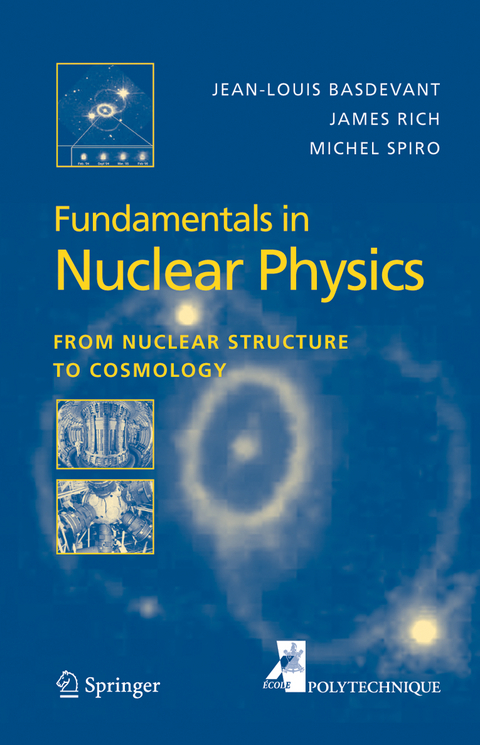
Fundamentals in Nuclear Physics
From Nuclear Structure to Cosmology
Seiten
2010
|
Softcover reprint of hardcover 1st ed. 2005
Springer-Verlag New York Inc.
978-1-4419-1849-9 (ISBN)
Springer-Verlag New York Inc.
978-1-4419-1849-9 (ISBN)
Nuclear physics began one century ago during the “miraculous decade” - tween 1895 and 1905 when the foundations of practically all modern physics were established. For nuclear physics, the critical discovery was that of radioactivity by Becquerel in 1896. This in turn led to atomic physics, solid state physics, and material science.
Nuclear physics began one century ago during the “miraculous decade” - tween 1895 and 1905 when the foundations of practically all modern physics were established. The period started with two unexpected spino?s of the Crooke’s vacuum tube: Roentgen’s X-rays (1895) and Thomson’s electron (1897), the ?rst elementary particle to be discovered. Lorentz and Zeemann developed the the theory of the electron and the in?uence of magnetism on radiation. Quantum phenomenology began in December, 1900 with the - pearance of Planck’s constant followed by Einstein’s 1905 proposal of what is now called the photon. In 1905, Einstein also published the theories of relativity and of Brownian motion, the ultimate triumph of Boltzman’s s- tistical theory, a year before his tragic death. For nuclear physics, the critical discovery was that of radioactivity by Becquerel in 1896. By analyzing the history of science, one can be convinced that there is some rationale in the fact that all of these discoveries came nearly sim- taneously, after the scienti?cally triumphant 19th century. The exception is radioactivity, an unexpected baby whose discovery could have happened s- eral decades earlier. Talentedscientists,theCuries,Rutherford,andmanyothers,tookthe- servationofradioactivityandconstructedtheideasthatarethesubjectofthis book. Of course, the discovery of radioactivity and nuclear physics is of much broader importance. It lead directly to quantum mechanics via Rutherford’s planetary atomic model and Bohr’s interpretation of the hydrogen spectrum. This in turn led to atomic physics, solid state physics, and material science.
Nuclear physics began one century ago during the “miraculous decade” - tween 1895 and 1905 when the foundations of practically all modern physics were established. The period started with two unexpected spino?s of the Crooke’s vacuum tube: Roentgen’s X-rays (1895) and Thomson’s electron (1897), the ?rst elementary particle to be discovered. Lorentz and Zeemann developed the the theory of the electron and the in?uence of magnetism on radiation. Quantum phenomenology began in December, 1900 with the - pearance of Planck’s constant followed by Einstein’s 1905 proposal of what is now called the photon. In 1905, Einstein also published the theories of relativity and of Brownian motion, the ultimate triumph of Boltzman’s s- tistical theory, a year before his tragic death. For nuclear physics, the critical discovery was that of radioactivity by Becquerel in 1896. By analyzing the history of science, one can be convinced that there is some rationale in the fact that all of these discoveries came nearly sim- taneously, after the scienti?cally triumphant 19th century. The exception is radioactivity, an unexpected baby whose discovery could have happened s- eral decades earlier. Talentedscientists,theCuries,Rutherford,andmanyothers,tookthe- servationofradioactivityandconstructedtheideasthatarethesubjectofthis book. Of course, the discovery of radioactivity and nuclear physics is of much broader importance. It lead directly to quantum mechanics via Rutherford’s planetary atomic model and Bohr’s interpretation of the hydrogen spectrum. This in turn led to atomic physics, solid state physics, and material science.
Introduction.- Basic concepts of Nuclear Physics.- Nuclear Models and Stability of the Nucleus.- Nuclear Reactions.- Nuclear Decays and Fundamental Interactions.- Radioactivity and all that.- Fission.- Fusion.- Nuclear Astrophysics.- Nuclear Cosmology.- Relativistic kinematics.- Accelerators.- Time-dependent perturbation theory.- Nutron transport.- Solutions and Hints for Selected Exercises.- Tables of numerical values.- Table of Nuclei.- References.- Index.
| Zusatzinfo | 184 Illustrations, black and white; XIV, 516 p. 184 illus. |
|---|---|
| Verlagsort | New York, NY |
| Sprache | englisch |
| Maße | 155 x 235 mm |
| Themenwelt | Naturwissenschaften ► Physik / Astronomie ► Astronomie / Astrophysik |
| Naturwissenschaften ► Physik / Astronomie ► Atom- / Kern- / Molekularphysik | |
| Naturwissenschaften ► Physik / Astronomie ► Plasmaphysik | |
| ISBN-10 | 1-4419-1849-3 / 1441918493 |
| ISBN-13 | 978-1-4419-1849-9 / 9781441918499 |
| Zustand | Neuware |
| Haben Sie eine Frage zum Produkt? |
Mehr entdecken
aus dem Bereich
aus dem Bereich
Grundlagen, Anwendungen in Astrophysik und Kosmologie sowie …
Buch | Softcover (2022)
Springer Spektrum (Verlag)
49,99 €
die Geschichte und Erforschung unserer Galaxie
Buch | Hardcover (2023)
C.Bertelsmann (Verlag)
30,00 €
Von Hubble-, James-Webb- und anderen Großteleskopen bis zu …
Buch | Softcover (2024)
Springer (Verlag)
22,99 €


